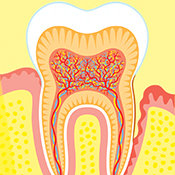Immune-Cell Treatment for Gum Disease Proves Promising
A recent study by Pitt researchers suggests that periodontal disease, which affects one out of two American adults, might be effectively treated by getting the right kind of immune-system cells to inflamed tissues. The findings, published in the Proceedings of the National Academy of Sciences, offer the possibility of a new therapeutic approach for this chronic condition.
recent study by Pitt researchers suggests that periodontal disease, which affects one out of two American adults, might be effectively treated by getting the right kind of immune-system cells to inflamed tissues. The findings, published in the Proceedings of the National Academy of Sciences, offer the possibility of a new therapeutic approach for this chronic condition.
Periodontal disease, characterized by red, swollen, and painful gums, as well as bone destruction, is typically treated by keeping oral bacteria in check with daily brushing and flossing, as well as with regular professional deep cleaning to remove tartar above and below the gum line.
“Currently, we try to control the build-up of bacteria so it doesn’t trigger severe inflammation, which could eventually damage the bone and tissue that hold the teeth in place,” said Charles Sfeir, the study’s coauthor and coinvestigator. “But that strategy doesn’t address the real cause of the problem, which is an overreaction of the immune system that causes a needlessly aggressive response to the presence of oral bacteria. There is a real need to design new approaches to treat periodontal disease.” Sfeir, who directs Pitt’s Center for Craniofacial Regeneration, is a professor of periodontics and oral biology in the School of Dental Medicine.
In the healthy mouth, a balance exists between bacteria and the immune system response to forestall infection without generating inflammation, said senior author Steven Little, a professor and chair of chemical and petroleum engineering in Pitt’s Swanson School of Engineering. But in many people, he added, a chronic overload of bacteria sets up the immune system to stay on red alert, causing harm to the oral tissues while it attempts to eradicate germs.
“There is a lot of evidence now that shows these diseased tissues are deficient in a subset of immune cells called regulatory T-cells, which tell attacking immune cells to stand down, stopping the inflammatory response,” said Little. “We wanted to see what would happen if we brought these regulatory T-cells back to the gums.”
is a lot of evidence now that shows these diseased tissues are deficient in a subset of immune cells called regulatory T-cells, which tell attacking immune cells to stand down, stopping the inflammatory response,” said Little. “We wanted to see what would happen if we brought these regulatory T-cells back to the gums.”
To do so, the researchers focused on periodontal disease in an animal model, developing a system of polymer microspheres to slowly release a chemokine, or signaling protein, called CCL22 that attracts regulatory T-cells. They then placed tiny amounts of the paste-like agent between the gums and teeth of animals with periodontal disease. The research team found that, even though the amount of bacteria was unchanged, the treatment led to improvements of standard measures of periodontal disease, including decreased pocket depth and gum bleeding, reflecting a reduction in inflammation as a result of increased numbers of regulatory T-cells. MicroCT-scanning showed lower rates of bone loss.
“Mummified remains from ancient Egypt show evidence of teeth-scraping to remove plaque,” noted Little. “The tools are better and people are better trained now, but we’ve been doing much the same thing for hundreds of years. Now, this homing beacon for T-reg cells, combined with professional cleaning, could give us a new way of preventing the serious consequences of periodontal disease by correcting the immune imbalance that underlies the condition.”
Next steps include developing the immune-cell strategy for human trials. The study was published in the Nov. 12, 2013, Proceedings of the National Academy of Sciences.
In addition to Sfeir and Little, the research team included bioengineering doctoral student Andrew J. Glowacki; Sayuri Yoshizawa, a research assistant professor of oral biology; and bioengineering doctoral student Siddharth Jhunjhunwala, all of the University of Pittsburgh; and Andreia E. Vieira and Gustavo P. Garlet of Sao Paulo University, Brazil.
Other Stories From This Issue
On the Freedom Road

Follow a group of Pitt students on the Returning to the Roots of Civil Rights bus tour, a nine-day, 2,300-mile journey crisscrossing five states.
Day 1: The Awakening
Day 2: Deep Impressions
Day 3: Music, Montgomery, and More
Day 4: Looking Back, Looking Forward
Day 5: Learning to Remember
Day 6: The Mountaintop
Day 7: Slavery and Beyond
Day 8: Lessons to Bring Home
Day 9: Final Lessons

